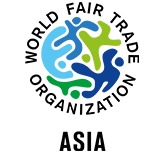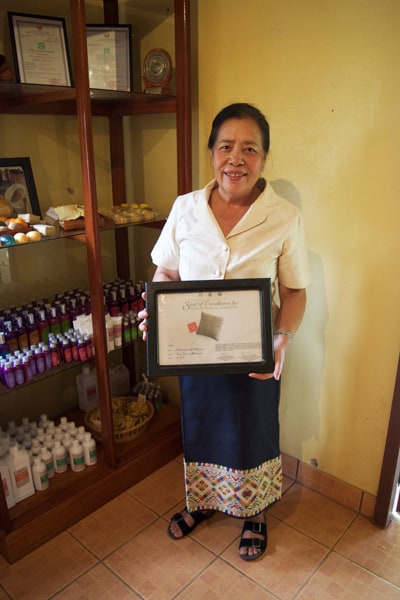
In 2005, an international group of women activists submitted the names of 1,000 women as a collective nomination for the Nobel Peace Prize. Although they did not win, PeaceWomen Across the Globe is still active, after producing a book, a film and an exhibition about the women they chose. One of those women was Kommaly Chanthavong, Director of Phontong-Camacrafts Handicrafts Cooperative and Mulberries. She is recognized for her contributions to social and economic development in Laos.
Kommaly was only 11 years old when her village was destroyed by U.S. bombers. She walked for a month to reach the capital, Vientiane. There, she met many other displaced and desperately poor families, most of them without any marketable skills. In 1976, she formed a cooperative with 10 members to share the silk-weaving skills her family had practised for generations. In 1990, they included Hmong and Lao village women, and in 1993, they established an organic silk farm. Today, the cooperative consists of 3,000 farmers, weavers and artisans from over 200 village families. Mulberries is their model farm and their Fair Trade logo.
What makes Laos silk special?
Laos’s silk production is traditionally natural and has not been changed or modernized. The breed of caterpillar we use hasn’t been changed. It’s been passed down from generation to generation without mixing with any other breed. In addition, because of the climate, the texture of Laos silk is different to other silks. It’s more like cotton or linen, which gives a specific quality to our work.
The traditional patterns have also been passed down to us through the generations. The patterns may be adapted as they are passed on, but we still have the original designs as well. It’s like treasure being passed from hand to hand, down the generations. The patterns we use are not copied from anyone or anywhere else — they’re unique to this area.
When children are learning how to weave, their parents teach them the different meanings of patterns. Girls start weaving between the ages of 14-16, around the time they start to have boyfriends. Perhaps their boyfriends will work outside or leave the village to study, so the girls weave them a gift to take. The message in it can have a pattern of the stars, which is a message to the boy that says, “If you miss me, look at the stars and think of me”, when they are apart.
What drives you; what motivates your work?
As a young girl, I wasn’t allowed to go to school, but I would sit outside the classroom and listen in on the classes. Educational opportunity in the north is very limited for women. We are expected to help with housework and be good at weaving – the future husband’s family judges the suitability of a girl by the strength of her silk skills: from the rearing of the mulberry tree to silk worms, to spinning and weaving.
Also, I experienced war when I was young. We experienced a lot of war — the war of independence from France and then the Vietnam War. When we had to go the caves for safety, we would take our weaving materials and silk worms with us. Such is the love and connection we have to our worms and our work.
I came back to this area to see how my family was doing, but I also wanted to preserve our culture, our traditions and the land. Our workers get money to send their children to school. We also encourage mothers to pass on their skills to their children, in order to preserve them.
We welcome anyone who wants to come here to learn these skills. For us, a priority is that the women make clothes for their own use, not just for selling — so they don’t have to go to the market and they are not making pieces that they themselves cannot wear. If they make more then we buy from them, there is still a market for them.
How does your Fair Trade and Organic model shape your work?
We plan our work around the land and the farmers’ harvest. The silk workers don’t plan around us – we accommodate their needs.
We were always organic, but we didn’t set out to be Fair Trade. Once we learnt the meaning of it, however, we realized we already met the criteria. Our work supported the poor villagers. Producing goods organically means the workers, consumers and environment are all safe. Women in rural areas don’t have the money to buy chemicals and we don’t want a dependency on them, so we teach them how organic can work.
Where do you find happiness?
My dream was for my children to study overseas, find very good jobs and work in a high-rise building. When this actually happened, I saw that in reality, my children were always chasing time, running to work, rushing for deadlines. That’s not happiness, so I try to bring my children back to live with nature and to help continue this work. That’s my happiness.
Think less about money and materials, live a more sustainable way and love and be happy with what you have. If you have something small or large share it with others.
(image credit: Mia Hardrill)
About Author:
Mia Hadrill is an advocate for Fair Trade and sustainability; she previously held a position at WFTO-Asia as Communications Manager. Prior to this, Mia worked directly with the CEO heading PR at People Tree, sustainable and Fair Trade fashion. Mia’s a CIPR Accredited Practitioner in Public Relations (PR), experienced in communications and advocacy for social businesses. Mia has also worked in advocacy for The Leprosy Mission, where she became a published author of an educational children’s book on leprosy. Mia’s experience extends to positions as a sustainable travel researcher and as PA to the Chair of the United Nations Association – Edinburgh.

